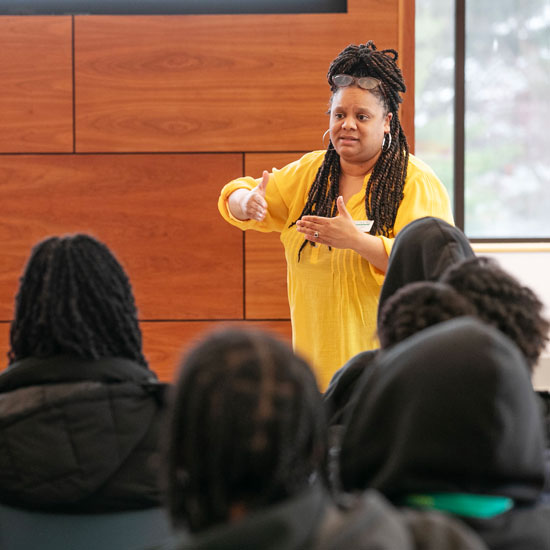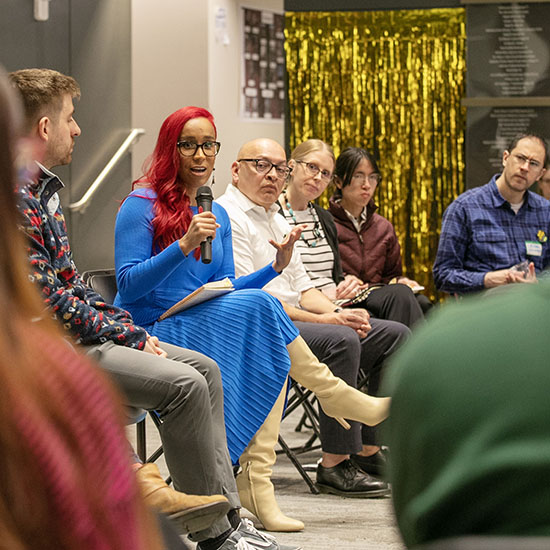Tang hosts retrospective of artist, activist, and educator Corita Kent
A comprehensive collection of work by one of America’s most popular and important graphic artists, including iconic images from the turbulent 1960s and 70s, will be on view at the Tang Teaching Museum at Skidmore College.
Someday is Now: The Art of Corita Kent runs through July 28, with an opening reception on Saturday, Jan. 26, from 6 to 7:30 p.m.
This is the first full-scale survey of more than 30 years of work by Corita Kent (1918–1986), legendary teacher at Immaculate Heart College in Los Angeles and civil rights, and anti-war activist. More than 200 of her vibrant serigraph prints, drawings, paintings, and rarely seen photos and videos from the Corita Art Center in Los Angeles combine to make this a comprehensive history of the artist.
“This is a wonderful time to celebrate and appreciate Corita Kent, and her optimistic belief in the power of art and teaching,” says Tang Dayton Director Ian Berry, who co-curated the exhibit with LA-based independent curator and art critic Michael Duncan.

E eye love, 1968
“In addition to being a great printmaker, she was also a dedicated and inventive—even revolutionary—teacher,” says Berry. Her classes at Immaculate Heart were an avant-garde mecca for other groundbreaking artists and innovators, from John Cage and Charles and Ray Eames, to Alfred Hitchcock and Buckminster Fuller.
Known as Sister Corita until she re-entered the secular world in 1968, Corita Kent created some of the best pop art of her era, with rule-breaking mash-ups of text from scripture, philosophers and poets, folk and rock lyrics, advertising slogans, and street signs—ingenious amalgams of faith and politics, popular culture and fine art, pain and hope.
In 1947, Kent began teaching art at Immaculate Heart College, where she helped foster a creative and collaborative arts community and developed a style of graphically innovative printmaking. Her hallmark mixture of bold, bright imagery and provocative texts proclaimed an upbeat theology in prints that re-purposed well-known advertising icons. As theologian and friend Harvey Cox noted, “She could pass her hands over the commonest of the everyday, the superficial, the oh-so-ordinary, and make it a vehicle of the luminous, the only, and the hope filled.”
Kent’s works continue to resonate with the public and inspire artists working today. One work, that they may have life (1964), annotates the familiar Wonder Bread design with the thought that “there are so many hungry people that God cannot appear to them except in the form of bread.” In for Eleanor (1964), with “the big G stands for goodness,” the viewer recognizes the General Mills logo and also recognizes that the big G stands for God.
An active spirit permeated Kent’s life, with printmaking a populist medium for communication with the world around her. In posters and murals, she posed philosophical questions about racism, poverty, war, and conflicts between radical and conservative positions inside the Catholic Church. Works such as manflowers (1969) touched directly on the brutalities of the war in Vietnam. In the print, Kent juxtaposed the texts “man power!” and “Where have all the flowers gone?” against an image of two injured young soldiers and bright green and purple blocks of color. She sought to address the stark realities of the world with messages of hope and joy, explaining: “It is a huge danger to pretend awful things do not happen. But you need enough hope to keep on going. I am trying to make hope. And you have to grab it where you can.”
Her designs were widely disseminated through billboards, book jackets, illustrations, and posters, and the hugely popular 1985 LOVE postage stamp. Printmaking, she explained, “enables me to produce a quantity of original art for those who cannot afford to purchase high-priced art…the distribution of these prints to everyday places of work pleases me, and I hope they will give people a lift.”
While several exhibitions have focused on Kent’s well-known 1960s serigraphs, Someday is Now is the first major museum show to survey her entire career, including early narrative works as well as watercolors made later in life when she was living in Boston.
A comprehensive catalogue is being developed in conjunction with the exhibit, featuring new scholarship, interviews with former students and collaborators, and responses from a wide variety of artists and designers..
In addition to the opening reception on January 26, the public is invited to the following events:
- Thursday, March 21, 5:30 pm – Corita Kent and the ‘60s panel discussion
- Thursday, March 21, 7:00 pm – Corita Art Party
- Saturday, March 23, 2:00-4:30 pm – Silkscreening workshop for all ages, in water-based silkscreen inspired by the art of Corita Kent; limited space (call 518-580-8080 for reservations)
- Tuesday, March 26, Noon – Curator’s Tour of Someday is Now: The Art of Corita Kent
Also opening at the Tang on January 26 are Opener 24–Carrie Moyer: Pirate Jenny; Elevator Music 24–Yoko Ono: Listen; and Paul Shambroom: Meetings, photographs shown in conjunction with the ongoing exhibit We the People.
The Tang Museum is open noon–5 p.m., Tuesday–Sunday, closed on Mondays and major holidays, and open until 9 p.m. on Thursdays. The Tang hosts some 40,000 visitors annually, ranging from local students who visit through programs with area schools to museum-goers from around the globe. For more information, visit www.skidmore.edu/tang, or call 518-580-8080.


